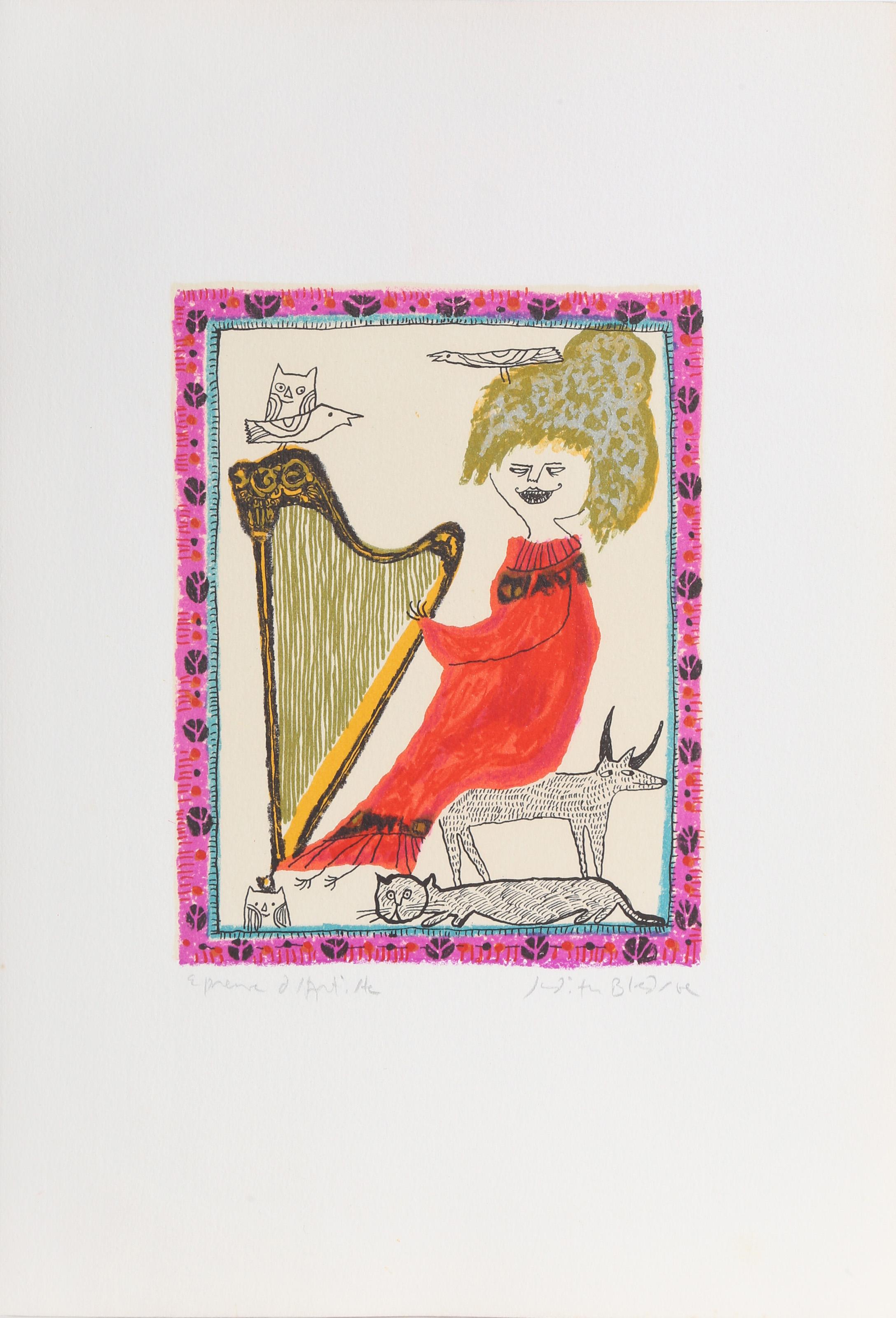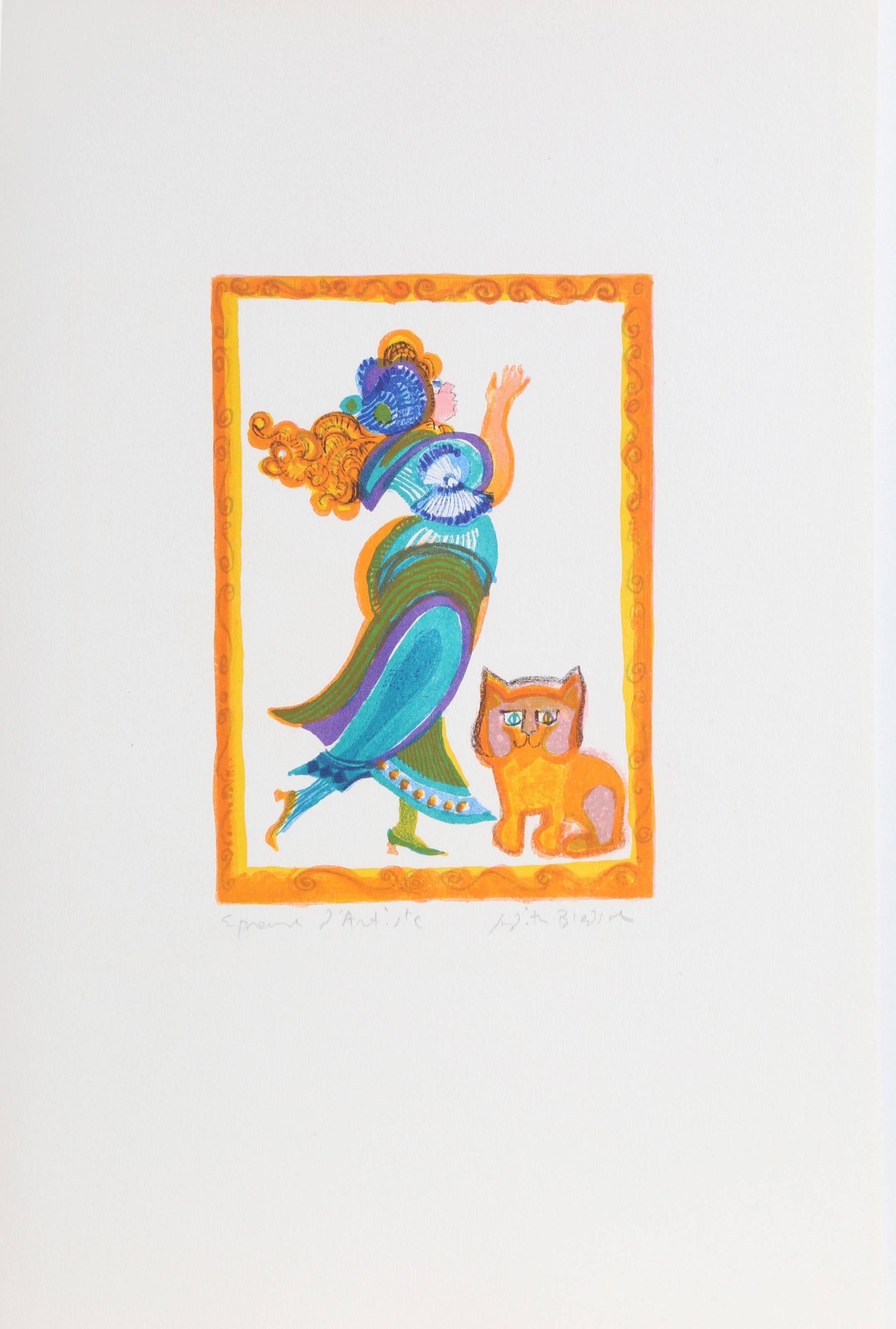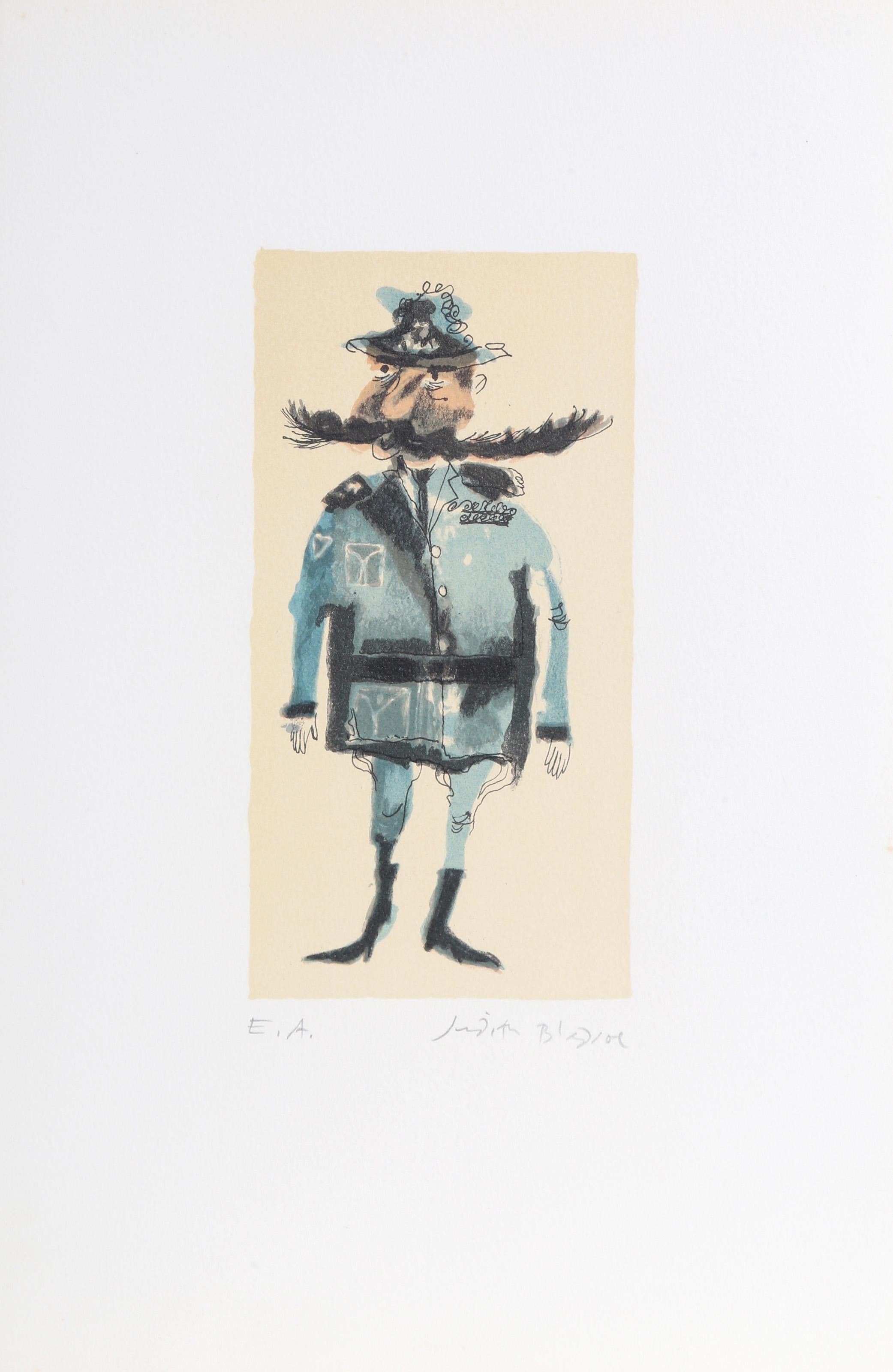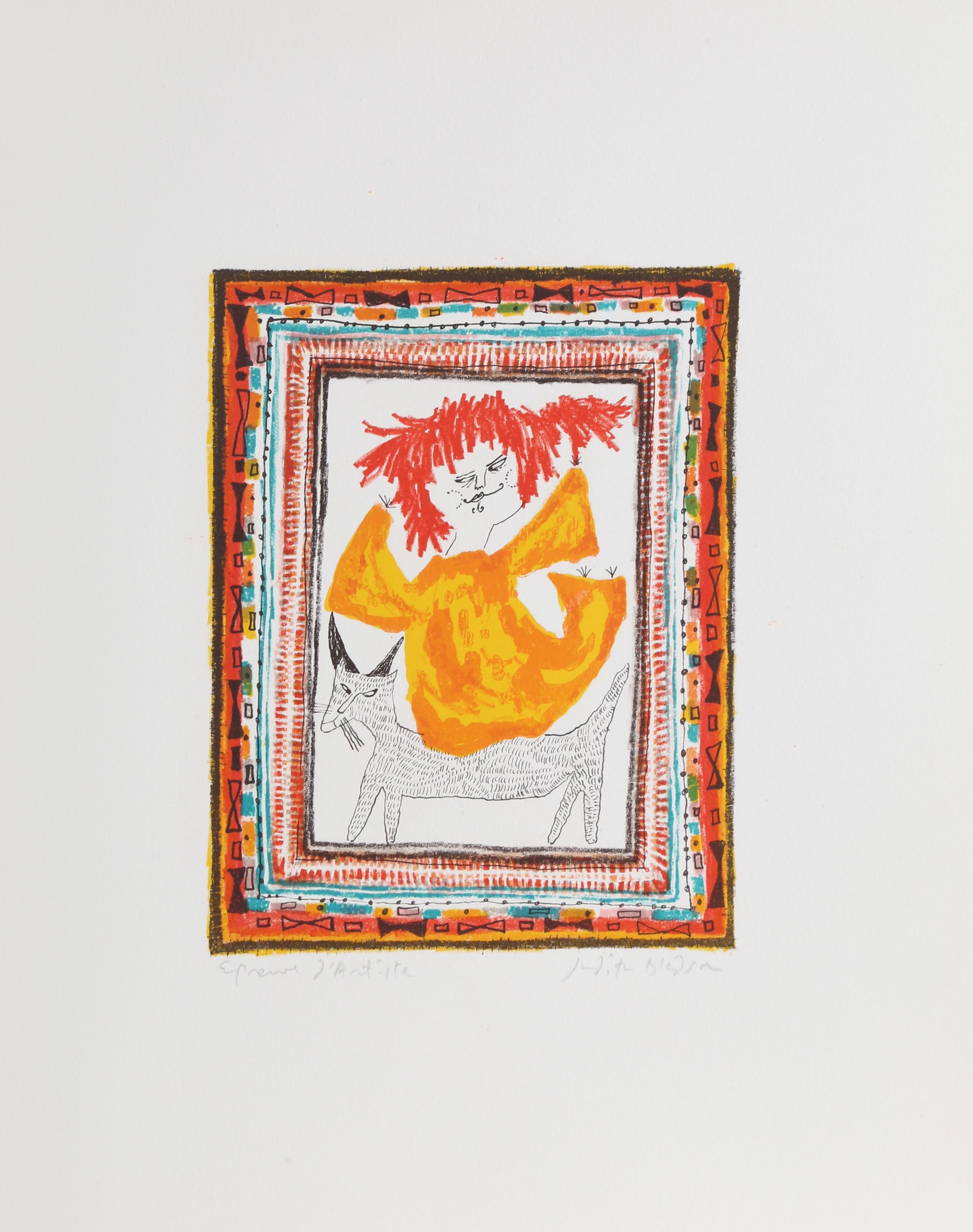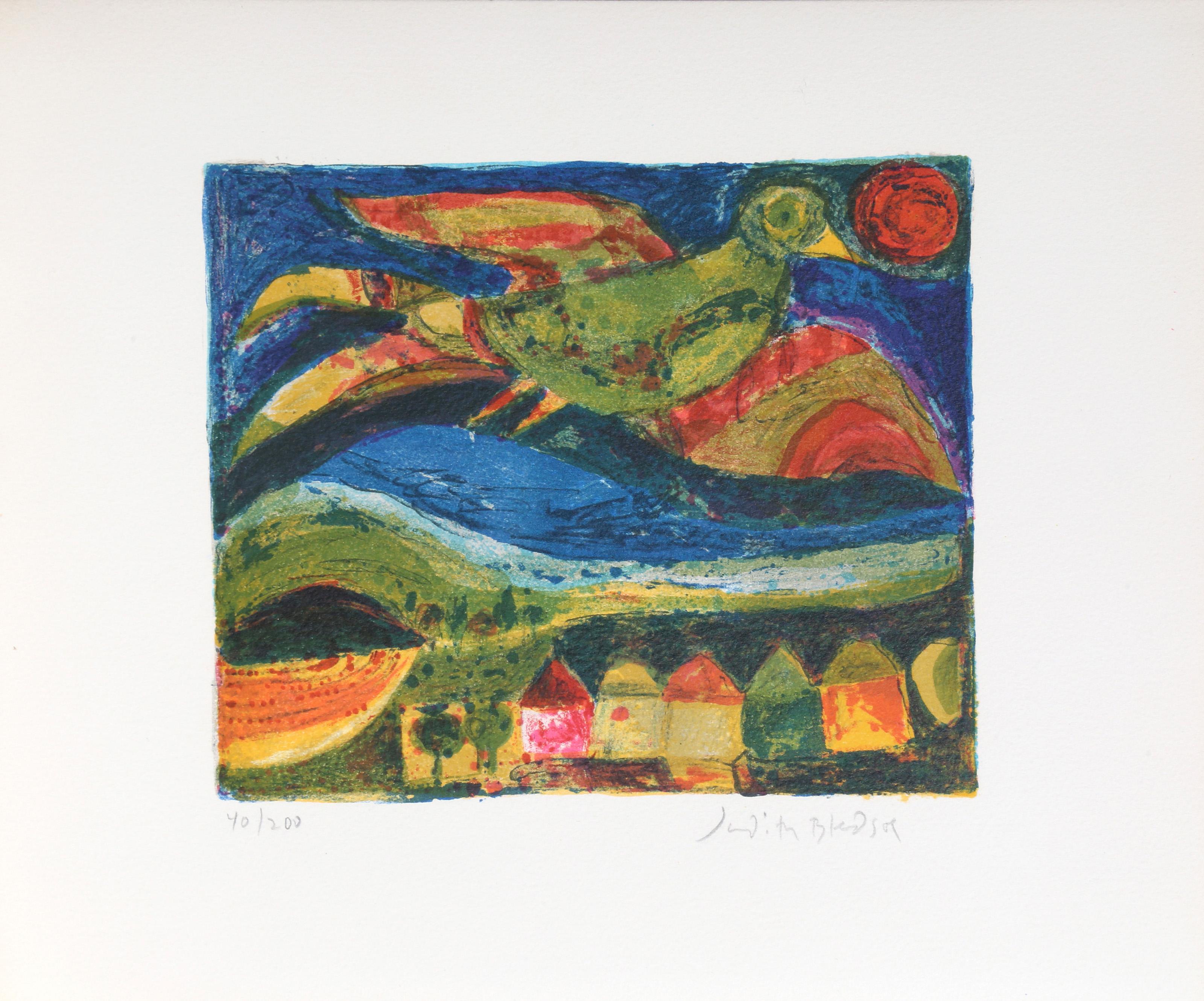Items Similar to Sagittarius from the Zodiac of Dreams Series, Lithograph by Judith Bledsoe
Want more images or videos?
Request additional images or videos from the seller
1 of 6
Judith BledsoeSagittarius from the Zodiac of Dreams Series, Lithograph by Judith Bledsoecirca 1970
circa 1970
About the Item
Judith Bledsoe, American (1938 - 2013) - Sagittarius from the Zodiac of Dreams Series. Year: circa 1970, Medium: Lithograph with Embossing, signed in pencil, Edition: EA, Size: 21 x 14.5 in. (53.34 x 36.83 cm), Description: Preparing to shoot while riding through the night, the figure of Sagittarius holds their bow and arrow as their hair flies back against the wind.
- Creator:Judith Bledsoe (1928, French)
- Creation Year:circa 1970
- Dimensions:Height: 21 in (53.34 cm)Width: 14.5 in (36.83 cm)
- Medium:
- Movement & Style:
- Period:
- Framing:Framing Options Available
- Condition:
- Gallery Location:Long Island City, NY
- Reference Number:
About the Seller
4.8
Gold Seller
These expertly vetted sellers are highly rated and consistently exceed customer expectations.
Established in 1979
1stDibs seller since 2014
2,709 sales on 1stDibs
Typical response time: <1 hour
- ShippingRetrieving quote...Ships From: Long Island City, NY
- Return PolicyA return for this item may be initiated within 7 days of delivery.
More From This SellerView All
- Petite Portrait - Harpist, Lithograph by Judith BledsoeBy Judith BledsoeLocated in Long Island City, NYJudith Bledsoe, American (1938 - 2013) - Petite Portrait - Harpist. Year: circa 1974, Medium: Lithograph, signed and numbered in pencil, Edition: EA, Image Size: 8 x 6 inches, Size:...Category
1970s Folk Art Prints and Multiples
MaterialsLithograph
- Petite Portrait - Woman in Gown with Cat, Lithograph by Judith BledsoeBy Judith BledsoeLocated in Long Island City, NYJudith Bledsoe, American (1938 - 2013) - Petite Portrait - Woman in Gown with Cat. Year: circa 1974, Medium: Lithograph, signed in pencil, Edition: EA, Image Size: 8 x 6 inches, Siz...Category
1970s Folk Art Prints and Multiples
MaterialsLithograph
- Petite Portrait - Policeman, Lithograph by Judith BledsoeBy Judith BledsoeLocated in Long Island City, NYJudith Bledsoe, American (1938 - 2013) - Petite Portrait - Policeman. Year: circa 1974, Medium: Lithograph, signed in pencil, Edition: EA, Image Size: 8 x 6 inches, Size: 15 x 10.5...Category
1970s Folk Art Prints and Multiples
MaterialsLithograph
- Petite Portrait - Red Hair Girl, Lithograph by Judith BledsoeBy Judith BledsoeLocated in Long Island City, NYJudith Bledsoe, American (1938 - 2013) - Petite Portrait - Red Hair Girl. Year: circa 1974, Medium: Lithograph, signed and dedicated to Laurent Marcel Salinas in pencil, Edition: EA...Category
1970s Folk Art Prints and Multiples
MaterialsLithograph
- Bird Flying Over Town, Lithograph by Judith BledsoeBy Judith BledsoeLocated in Long Island City, NYJudith Bledsoe, American (1938 - 2013) - Bird Flying Over Town. Year: circa 1974, Medium: Lithograph, signed and numbered in pencil, Edition: 200, Size: 15 x 10.5 in. (38.1 x 26.6...Category
1970s Folk Art Prints and Multiples
MaterialsLithograph
- Petite Portrait - Trumpeter, Lithograph by Judith BledsoeBy Judith BledsoeLocated in Long Island City, NYJudith Bledsoe, American (1938 - 2013) - Petite Portrait - Trumpeter. Year: circa 1974, Medium: Lithograph, signed in pencil, Edition: EA, Image Size: 8 x 6 inches, Size: 15 x 10.5...Category
1970s Folk Art Prints and Multiples
MaterialsLithograph
You May Also Like
- Naive Lithograph Paris Train Station Wedding Party, Honeymoon Scene Folk ArtLocated in Surfside, FLHand signed, limited edition on BFK Rives French art paper. I believe the title is Honeymoon. Jan Balet (20 July 1913 in Bremen – 31 January 2009 in Estavayer le Lac, Switzerland), was a German/US-American painter, graphic artist and illustrator. Affected by the folk art style of naive art he worked particularly as a graphic artist and as an Illustrator of children's books. His works exhibit a dry wit and refreshingly candid, whimsical, satirical view of life. His uncle was the famous painter and illustrator Benno Eggert. Many well-known personalities of the time were friends of his grandfather, i.e. the painters Hans Purrmann, Karl Caspar, Maria Caspar-Filser (cousin of his mother), the writer Martin Andersen Nexo, the Swabian poet Wilhelm Schussen as well as the poet and writer Oskar Wöhrle. In 1929, at the age of 17, he moved to Berlin at the invitation of his father and studied Drawing at the college of Arts and Crafts (Kunstgewerbeschule Ost am Schlesischen Bahnhof). A year later, he went to live with his mother and his grandmother, in Munich. Balet transferred his studies to the Munich College of Arts but was dismissed in 1932. He went on to study with Professor Ege, at a private school for commercial art. During this time he also worked at an institute for lithography and for the art gallery Wallach. Balet rented his first small studio at the age of nineteen, where he manufactured and sold hand colored Bavarian woodcuts. 1934 he passed the entrance examination to the Akademie der Bildenden Künste München and undertook further studies with Olaf Gulbransson. His work is of a popular style similar to Michel Delacroix, Charles Fazzino and James Rizzi. In early 1938 Balet was recruited by the German military and because his ancestor's passport was not complete, he was forbidden to associate further with the Akademie der Bildenden Künste München. Later that year Balet emigrated to the USA, settled in New York and painted rustic furniture for a living. One winter he jobbed as a skiing teacher in Vermont and occasionally jobbed as an advertising commercial artist. Among other projects, he painted the cafeteria of the largest of New York's department stores R.H. Macy. From time to time Balet's designs appeared in the fashion magazine Mademoiselle and in 1943 he became Art Director at the magazine. Balet became so successful as a commercial artist that he was able to give up paid employment and start his own business. He worked for the radio station CBS, magazines such as Vogue, House and Garden, House Beautiful, The Saturday Evening Post, Glamour, Good Housekeeping, This week. After the war ended in 1945 he acquired U.S. citizenship. Balet commuted between his studio in New York and an old, boat house in the dunes of Montauk, Long Island, which he had converted to a studio where he painted and drew. His first children's book Amos and the Moon was published in 1948. Despite what was regarded in the USA as fashionable art Abstract, Op-art and Pop Art, Balet continued to paint in his own naif style. Art work (Children books and sketchbooks) 1948 Amos and the moon, Henry Z. Walck Verlag New York 1949 Ned, Ed and the lion 1951 What makes an orchestra 1959 The five Rollatinis, J. B. Lippincott Co. Verlag New York 1965 Joanjo, Pharos Verlag Basel 1966 Das Geschenk Eine portugiesische Weihnachtsgeschichte, Betz-Verlag München 1967 Der König und der Besenbinder, Betz-Verlag München 1969 Der Zaun, Otto Maier Verlag München 1969 Ladismaus, Betz-Verlag München 1979 Ein Skizzenbuch, Windecker Winkelpresse 1980 Katzen-Skizzen, Windecker Winkelpresse 1981 Skizzen-Paare, Windecker Winkelpresse 1981 Die Leihkatze oder Wie man Katzen lieben lernt, Windecker Winkelpresse (Author: Otto Schönberger) 1982 Paris-Skizzen, Windecker Winkelpresse 1984 Hellas-Skizzen, Windecker Winkelpresse 1993 Wasser-Skizzen, Edition Toni Pongratz 1994 Die Zeppeline des Jan Balet, Zeppelin-Museum Friedrichshafen (Taschenbuch) 2008 Angekommen: Gedichte (Author: Hans Skupy) Publicationen, which Jan Balet illustrated 1945 Alarcon, P.A.: Tales from the Spanish, Allentown 1948 Hanle-Zack, D.: The golden ladle, Chicago-New York 1952 Wing, H.: Rosalinda, Chicago 1953 Wing, H.: The lazy lion...Category
20th Century Folk Art Figurative Prints
MaterialsLithograph
- Untitled, from from the Artsounds CollectionBy Thomas Lanigan-SchmidtLocated in New York, NYThomas Lanigan-Schmidt Untitled, from from the Artsounds Collection, 1986 Lithograph on paper Signed and numbered from the edition of 200 in ink on the back; also bears artist's stamped name and provenance - Art Sounds portfolio. 12 × 12 inches Unframed Signed and numbered from the edition of 200 in ink on the back; also bears artist's stamped name and provenance - Art Sounds portfolio. This terrific offset lithograph print exemplifies the combination of religion and kitsch that Lanigan Schmidt is best known for. This print was created in the 1980s for the famous Artsounds portfolio, which featured prints by Marcel Duchamp, Jonathan Borofsky among others. Lanigan-Schmidt was a subject of a 2013 retrospective at PS1 MOMA and is on the faculty of the School of Visual Arts in New York. Provenance: Artsounds Portfolio About Thomas Lanigan-Schmidt: Thomas Lanigan-Schmidt is represented in the collections of the Metropolitan Museum of Art, Whitney Museum of American Art, MoMA, Brooklyn Museum, Ludwig Forum für Internationale Kunst, Ackland Art Museum, Columbus Museum of Art, and Wadsworth Atheneum Museum of Art, among others. He has exhibited extensively throughout the United States and Europe, including the 1980 and 1984 Venice Biennales, the 1991 Whitney Biennial, and the 1999 exhibition The American Century: Art and Culture, 1950-2000, Whitney Museum of American Art, New York, NY. Recent solo exhibitions include Tenemental: With Sighs Too Deep for Words, Howl! Happening, New York (2018); Thomas Lanigan-Schmidt: Mysterium Tremendum, Rockland Art Center, NY (2013); and Ecce Homo: Thomas Lanigan-Schmidt & The Art of Rebellion, Pavel Zoubok...Category
1980s Outsider Art Figurative Prints
MaterialsLithograph
- Israeli Naive Art Screen Print Lithograph Jerusalem, Sanhedrin Old City Folk ArtBy Gabriel CohenLocated in Surfside, FLBold color lithograph, hand signed in pencil and numbered AP IX/X (artist’s proof 9/10), Jerusalem Print Workshop blind stamp lower right. On French Arches paper. Gabriel Cohen, Self taught, Naive painter was born in Paris in 1933, to parents from Jerusalem with a father who studied the kabbalah. Throughout World War II, the family hid from the Nazis in Paris. Images of Nazi soldiers appear in several of his paintings. In 1949, when Gabriel was 16, the family returned to Israel. They managed to save enough money to move back to the quarter where both parents were born: Ohel Moshe in Nachlaot. Gabriel served in the artillery corps and after the army, went back to live in his parents' house and earned a living polishing diamonds. The head of the polishing plant, who noticed his employee's artistic skill, allowed him to paint during work hours. He once asked Cohen if he could draw a tiger. Cohen drew him a tiger. And he did a lot of sculpting and painting on glass. He also loved to play the guitar, especially flamenco style. Critics say he is one of Israel's greatest naive-style painters. Along with Shalom of Safed, Kopel Gurwin and Natan Heber, He is renowned as one of Israel's greatest living naive-style folk art painters, recipient of the Jerusalem Prize for Art (1987), a permanent entry in encyclopedias of naive painting, who exhibited his work not only in Israel, but also in Paris, Venezuela, Denmark and Germany; the same Gabriel Cohen whose colorful , bold paintings were exhibited at the Jewish Museum in New York in 1987 alongside works by Marc Chagall; the same Gabriel Cohen about whom curator and art scholar Gideon Ofrat says, "There is no questioning his greatness." He has shown in Paris on the Rue de Rosiers in the Marais. His impressions of his journeys, mostly imaginary, yet some real, are expressed in Cohen's paintings. Huge, colorful canvases rich in precise detail and fantasy, in which he paints the Eiffel Tower and the Russian steppes or the vistas of Paris and the Tower of Babel "In my opinion, it's also because the Tower of Babel has some kind of phallic, erotic meaning, but also because of the internationalism, of the mixture and confusion of nations, which is an essential element in Gabi Cohen's work," says Gideon Ofrat. There is no superlative that has not been lavished on Cohen's work by art critics, since he began showing his paintings at age 40, All the art critics seemed to agree at once that Cohen is one of the greatest naive-style painters in Israel. Their counterparts abroad seconded this view. About a year and a half ago, Zadka organized a show for Cohen at the Jerusalem Artists' House. The Tel Aviv Museum bought a painting of Gabi's and so did the Israel Museum, and several artists bought his drawings. He is a great, great painter. There is no painter who is more of a symbolist and illustrative artist than he is. As a painter myself, I admire him." The Yom Kippur War in 1973 sparked an artistic breakthrough for Cohen; it was at that time that he began to sit on the sidewalk after his work as a diamond polisher and paint. Not long afterward, in early 1974, he did a painting he called "Moses on the Mountain." Ruth Debel, of the Debel Gallery in Ein Kerem, passed by and saw it on the street. She asked how much he wanted for it, and for the first time in his life, he realized that his work had financial value. His first show was at the Debel Gallery in 1974. The response was overwhelming. Cohen was immediately declared a genius. His paintings at the gallery were purchased and he continued to create new paintings. That same year, he was invited to take part in a group exhibition of naive artists at the Kunsthaus in Zurich, and a year later, his work was included in a traveling show of naive-style artists from Israel that was exhibited in Denmark and Germany. Soon after that he was invited to be part of group shows in Venezuela and at the Tel Aviv Museum. Cohen had four solo shows at the Debel Gallery. Awards And Prizes 1987 Jerusalem Prize for Painting and Sculpture 1999 Shoshana Ish-Shalom Prize for special contribution to art, Jerusalem He has exhibited alngside all of the Israeli great artists. including Naive Art Group exhibition Gvanim Art Gallery, Jerusalem Rubin, Rachel Roman, Yitzhak Zarembo, Leah Moscovitz, Shalom (of Safed) Steinberg, Michael Danisov, Salva Harbon, Haim Cohen, Gabriel Chanannia, Joseph (Jojo) Local Hero...Category
20th Century Folk Art Landscape Prints
MaterialsScreen, Lithograph
- Autumn in New York by Jane Wooster ScottBy Jane Wooster ScottLocated in Larchmont, NYJane Wooster Scott (American, b. 1920) Autumn in New York, c. 20th Century Lithograph Sight: 15 x 12 in. Framed: 27 3/4 x 23 3/4 x 1 in. Signed and titled lower right in plate: Autum...Category
20th Century Folk Art Landscape Prints
MaterialsLithograph
- Bubby and Zayde, Judaica Folk Art Jewish LithographBy Michoel MuchnikLocated in Surfside, FLThe title of the piece makes reference to the subject of the piece, in this case Bubby (Grandmother in Yiddish) and Zayde (Grandfather in Yiddish). In terms of style, it looks illustrative, cartoonist, and fairy-tale like. Edition 76/260. Michoel Muchnik was born in Philadelphia in 1952. Muchnik received his artistic training at the Rhode Island School of Design. He later studied Jewish and Talmudic studies at the Rabbinical College of America in Morristown, New Jersey. Michoel Muchnik's art focuses on imaginative and joyful depictions of traditional and mystical Jewish and Hasidic themes. Muchnik has exhibited his work and lectured on Hasidic art throughout the United States as well as abroad. In 1977, Muchnik was selected alongside four other Hasidic artists, including Hendel Lieberman...Category
Late 20th Century Folk Art Figurative Prints
MaterialsLithograph
- American Folk Blues Festival poster 1969 by Gunther Kieser (Blues music)By Günther KieserLocated in NEW YORK, NYGunther Kieser American Folk Blues Festival poster 1969: Keiser's Blues guitar poster for the annual Hamburg festival devoted to American folk blues feat...Category
1960s Folk Art Prints and Multiples
MaterialsLithograph, Offset

